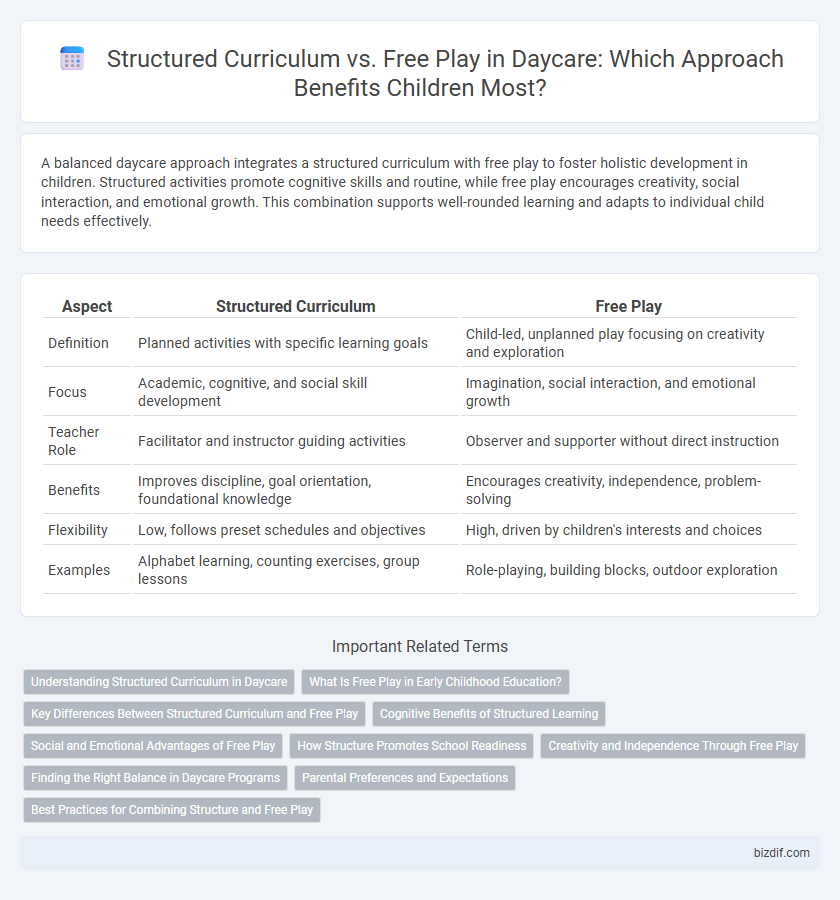A balanced daycare approach integrates a structured curriculum with free play to foster holistic development in children. Structured activities promote cognitive skills and routine, while free play encourages creativity, social interaction, and emotional growth. This combination supports well-rounded learning and adapts to individual child needs effectively.
Table of Comparison
| Aspect | Structured Curriculum | Free Play |
|---|---|---|
| Definition | Planned activities with specific learning goals | Child-led, unplanned play focusing on creativity and exploration |
| Focus | Academic, cognitive, and social skill development | Imagination, social interaction, and emotional growth |
| Teacher Role | Facilitator and instructor guiding activities | Observer and supporter without direct instruction |
| Benefits | Improves discipline, goal orientation, foundational knowledge | Encourages creativity, independence, problem-solving |
| Flexibility | Low, follows preset schedules and objectives | High, driven by children's interests and choices |
| Examples | Alphabet learning, counting exercises, group lessons | Role-playing, building blocks, outdoor exploration |
Understanding Structured Curriculum in Daycare
A structured curriculum in daycare incorporates planned activities designed to foster cognitive, social, and motor skills development following specific educational standards. This approach supports consistent learning outcomes by guiding children through age-appropriate milestones and facilitating teacher-led instruction. Research highlights that structured curricula enhance early literacy and numeracy skills, preparing children for formal schooling environments.
What Is Free Play in Early Childhood Education?
Free play in early childhood education refers to child-initiated activities that promote creativity, problem-solving, and social skills without direct adult instruction. It allows children to explore their environment freely, fostering cognitive and emotional development by encouraging imagination and decision-making. This unstructured time supports holistic growth by enabling children to engage in self-directed learning experiences essential for building independence.
Key Differences Between Structured Curriculum and Free Play
Structured curriculum in daycare involves planned activities guided by educational goals, emphasizing skill development and cognitive growth through teacher-led instruction. Free play allows children to explore and learn independently, fostering creativity, social skills, and decision-making in an unregulated environment. Key differences include the level of adult involvement, with structured curriculum promoting focused learning outcomes, while free play supports spontaneous engagement and emotional expression.
Cognitive Benefits of Structured Learning
Structured curriculum in daycare settings enhances cognitive development by providing age-appropriate activities that promote problem-solving, memory, and language skills. Research indicates children exposed to systematic learning frameworks demonstrate improved critical thinking and better academic readiness compared to solely free play environments. Incorporating targeted lessons on numeracy, literacy, and science concepts fosters neural pathways essential for long-term cognitive growth.
Social and Emotional Advantages of Free Play
Free play in daycare settings significantly enhances children's social and emotional development by fostering creativity, independence, and problem-solving skills through unstructured interactions. It encourages peer collaboration, empathy, and conflict resolution, creating a foundation for strong emotional intelligence. Research shows that children engaged in free play demonstrate improved self-regulation and resilience compared to those in strictly structured curriculums.
How Structure Promotes School Readiness
A structured curriculum in daycare settings promotes school readiness by providing consistent routines that enhance cognitive and social-emotional development. Research shows children exposed to planned learning activities demonstrate improved literacy, numeracy, and self-regulation skills essential for formal education. Structured environments help children adapt to classroom expectations, fostering concentration and cooperation necessary for academic success.
Creativity and Independence Through Free Play
Free play in daycare settings significantly enhances creativity and independence by allowing children to explore their interests without rigid guidelines. This unstructured approach cultivates problem-solving skills, imaginative thinking, and self-confidence more effectively than a strictly structured curriculum. Encouraging free play fosters natural learning processes, helping children develop autonomy and emotional resilience.
Finding the Right Balance in Daycare Programs
Finding the right balance between a structured curriculum and free play in daycare programs enhances child development by combining guided learning with creativity and social skills growth. Structured curriculum activities promote cognitive milestones and foundational knowledge, while free play encourages imagination, problem-solving, and emotional regulation. Integrating both methods tailors the learning environment to support diverse developmental needs and optimize overall well-being.
Parental Preferences and Expectations
Parents often weigh the benefits of a structured curriculum against the flexibility of free play when selecting daycare programs. Many expect a balanced approach that promotes cognitive development through guided activities while fostering creativity and social skills via unstructured play. Research shows that combining structured learning with ample free play aligns with parental priorities for holistic child development.
Best Practices for Combining Structure and Free Play
Combining a structured curriculum with free play in daycare settings enhances children's cognitive and social development by balancing guided learning and creativity. Best practices include allocating specific times for focused activities such as literacy and numeracy, while ensuring ample periods for unstructured play to foster imagination and problem-solving skills. Integrating both approaches supports holistic growth, promotes engagement, and adapts to diverse learning styles in early childhood education.
Structured curriculum vs Free play Infographic

 bizdif.com
bizdif.com